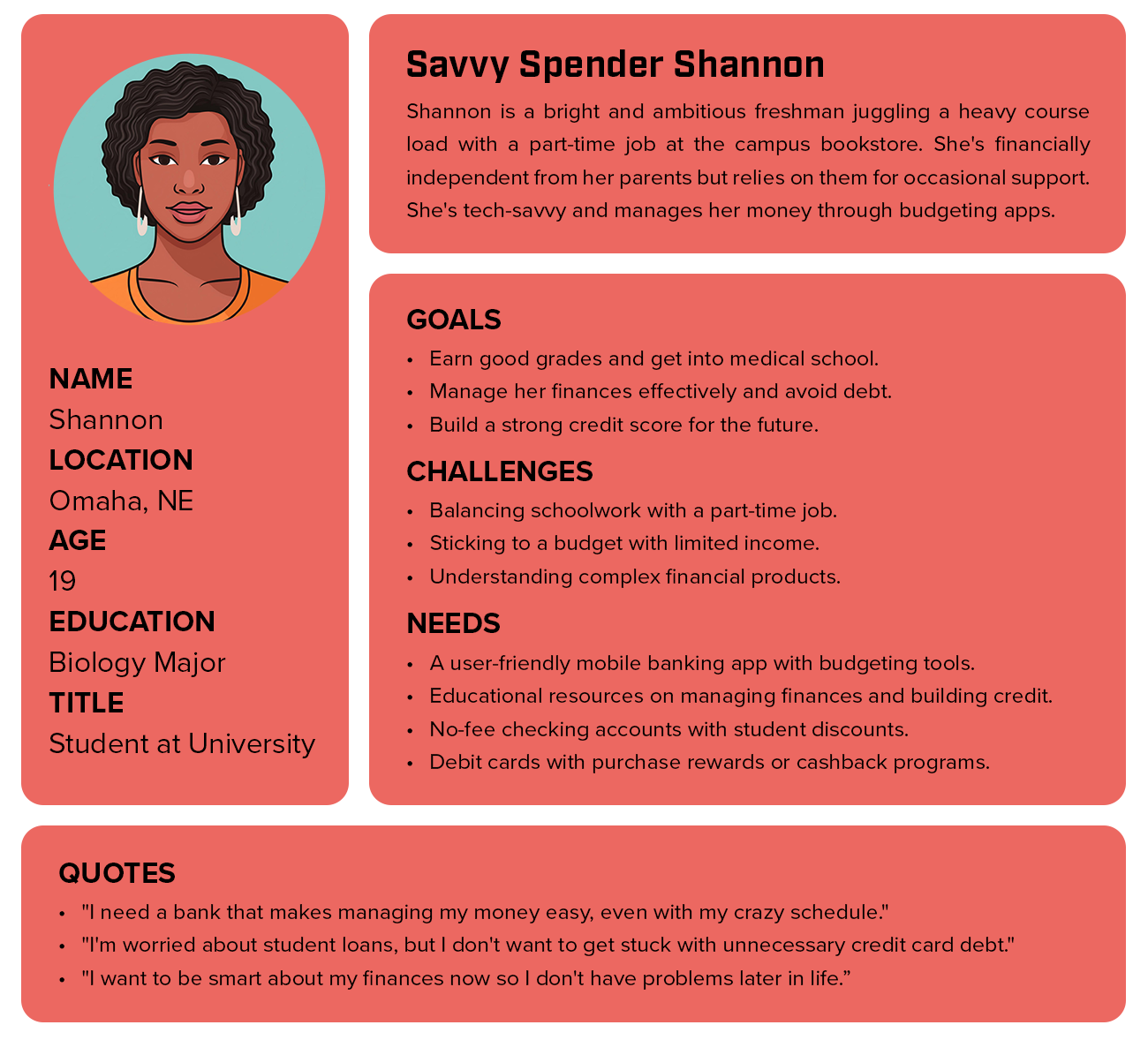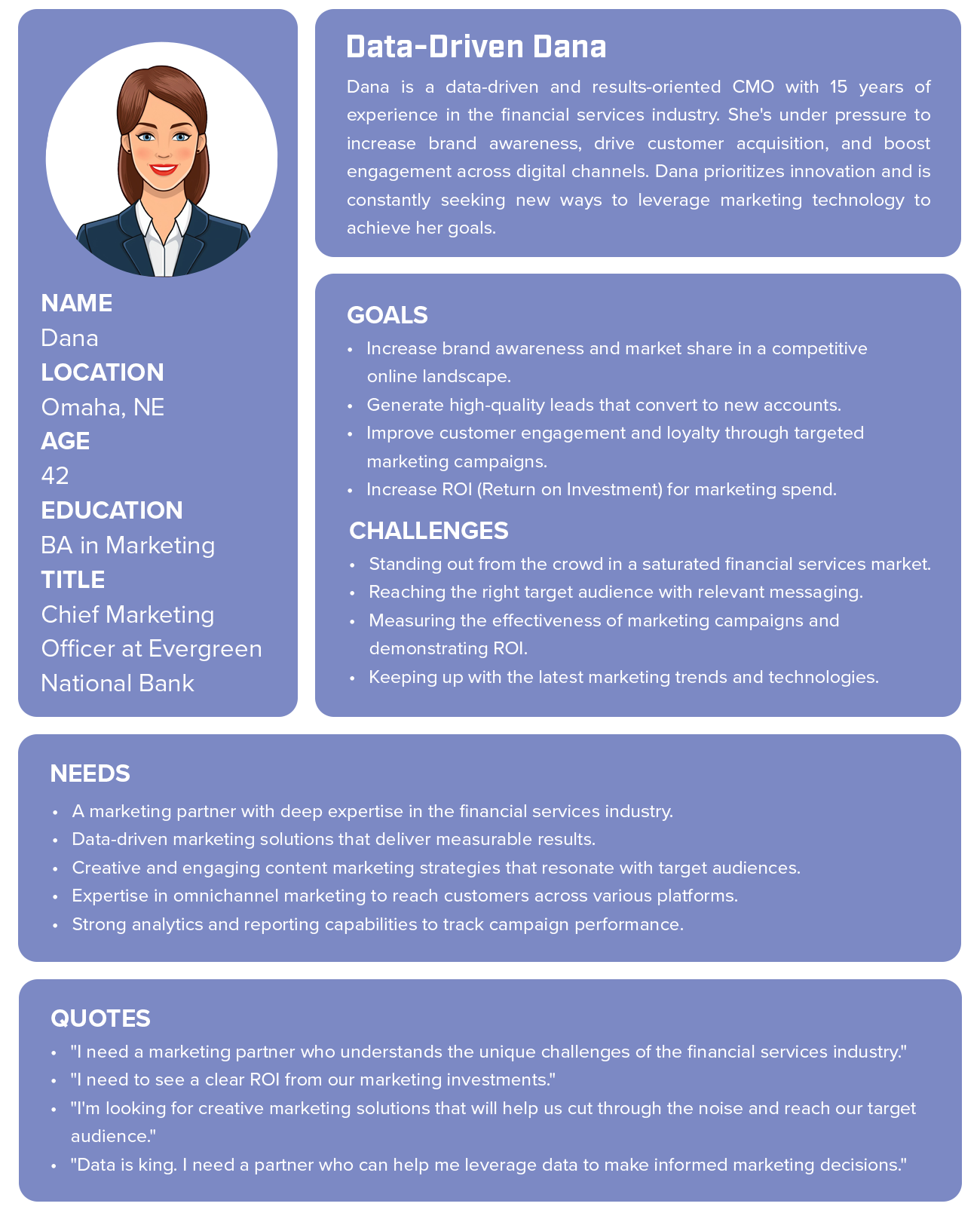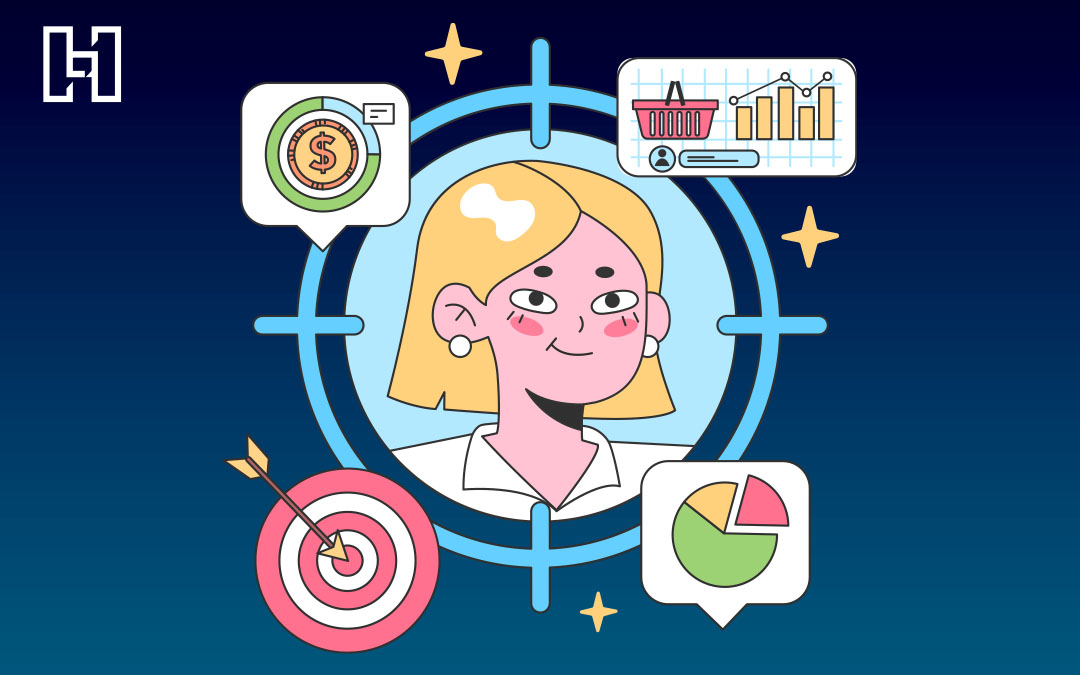A buyer persona helps brands identify and target certain buyers within their audience for a successful marketing campaign. Check out our guide on how to build a buyer persona that goes beyond the basics—and take advantage of our template!

What Is a Buyer Persona?
A buyer persona is a data-informed description of the ideal customer for your business. They typically include a fictional profile composed of actual demographic and psychographic information from your target audience. Depending on what industry you’re in, you’ll likely have multiple buyer personas for different business goals.
For example, Hurrdat Marketing targets a variety of small to medium-sized businesses, while Hurrdat Sports Bar targets local families and sports fans. Buyer personas can be built for both audiences to more effectively market to them, but there are a few variables to consider, including the difference between business-to-business (B2B) and business-to-consumer (B2C) personas.
B2B Buyer Personas
- Acknowledge business needs in the decision-making process
- Consider details like budgets, ROI, & industry regulations
- Factor in more complex sales cycles
B2C Buyer Personas
- Acknowledge emotional influence in the customer journey
- Consider details like demographics & lifestyle choices
- Factor in shorter buyer journeys, focusing on purchasing triggers
Why Create a Buyer Persona?
An important tool in understanding your ideal customer’s thoughts, goals, and actions, accurate buyer personas can increase sales through personalized ads and improve the likelihood of repeat customers. In fact, 93% of companies who segment their customers by buyer personas exceed lead and revenue goals.
Buyer personas can also help with:
- Delivering relevant marketing campaigns to your target audience
- Prioritizing important marketing channels
- Ensuring your copywriting, design, & content resonates with your audience
- Helping teams make quick, impactful decisions
- Inform future service and product development
While the primary goal of this marketing tactic is to describe who you want to cater to, it’s helpful to consider a negative buyer persona—customers you don’t want to attract because your product or service isn’t relevant to them. Knowing your negative personas help you narrow your marketing toward your ideal customers.
What Should a Buyer Persona Include?
A well-crafted buyer persona should include both quantitative and qualitative data to create a well-rounded profile that defines the voice and tone of your ideal customer. Understanding your customer through excellent data collection tactics will help you determine how they consume content, what content they engage with most, and the best way to reach them—whether that’s via emails, blogs, video advertising, or social media marketing.
Here are some common demographics to include in your buyer persona:
- Age
- Location
- Education
- Occupation
- Communication Preferences (e.g., email, mail, etc.)
- Preferred Social Media Platform
- Goals
- Motivations
- Needs
- Challenges
- Quotes
How to Do Buyer Persona Research
Buyer personas should be clear, detailed, and backed up by solid research. Depending on what kind of information you need and what your resources are, there are quite a few buyer persona research options. Follow these steps to develop accurate and reliable buyer personas, or improve the ones you already have.
Dig In to Analytics
Make informed decisions when creating your buyer persona by pulling your audience’s demographic data from your social media platforms, website, email marketing, and paid advertising campaigns. Most platforms and automated marketing tools record basic information like your audience’s age and location as well as track how they engage with the content your brand already produces—which helps illustrate your customers’ background.
If you’ve already created a basic buyer persona, consider taking analytics a step further by implementing additional data-based marketing tactics. Strategies like A/B testing can help you learn more about your existing customers by measuring what content resonates with them most.
For example, if you know what kind of email subject lines, social posts, and blog topics your audience engages with most, see how making them more specific with affect your audience. If only half engage with the test content, you can add that information to your existing buyer persona.
Research Competitors
No matter what industry your business is in, scoping out the competition is a necessity. First, identify who your competition is by looking at who else your audience follows on social media within your industry or niche. Then, investigate their audience by reading their comments and looking at their profiles to learn more about them. Take this opportunity to evaluate tactics your competitor is employing that successfully drive engagement. This information will help you further define your buyer persona and take note of what marketing tactics you should try.
If you’re ready to conduct additional research to supplement your buyer persona, there are a few things you can do. Delve into specific niches within your industry and observe those particular audiences so you can further define and segment your personas. Explore indirect competitors who are offering similar products and services or are in a related industry to identify different, overlapping branches of your audience to create multi-faceted personas. And utilize advanced marketing tools like Hootsuite, Similarweb, and the Market Explorer from Semrush, which can analyze and track your competition’s success with their audience.
Review Surveys
Customer surveys and feedback offer opportunities to gather both qualitative and quantitative data about a user’s overall experience, decision-making process, and more. For quantitative data, consider surveys that include yes or no questions, multiple choice questions, or rating scales. An example of this might be a numbered scale between one and ten with the question, “How satisfied are you with your overall experience using our product/service?” followed by a multiple choice list of common answers to “What factors contributed most to your rating?” This type of survey requires less effort than interviews as it takes less time, does not require one-on-one communication, and can be automated while still helping you understand trends, pain points, and motivations.
For qualitative data, your surveys can include questions that require longer, more personalized answers. Surveys looking for feedback are a great place to implement this kind of survey because it can give you specific information on how different people responded to different variables in the buyer’s journey.
If you’re having trouble getting people to fill out your surveys, consider gamifing your data collection by creating a fun, interactive interface that rewards surveyed customers with incentives like coupons, discounts, and other deals. You can also use this as a way to get better answers to more detailed questions as you work to improve your buyer persona.
Interview Customers
A good way to gather qualitative data with firsthand insights from people using your business or services, customer interviews typically happen after an initial touch point—like after a sale or prompting to share on social media. Similar to surveys, you can give customers incentives to encourage them to participate.
When you interview, make sure to ask questions that align with your goals. You can start with questions like:
- Why did you buy today?
- Why did you buy our product?
- What alternatives did you choose us over and why?
- Where did you look for information when making this decision?
- Why did you buy this now as opposed to earlier or later?
- What did you consider purchasing but decide against?
- How long have you been considering buying?
Improve your buyer persona by asking more in-depth questions, conducting more interviews, and targeting specific customers. Look at those who have started their buyer journey but have not yet made a purchase. Ask what is preventing them from purchasing and what would make them complete a purchase. Other in-depth questions could be:
- What concerns or reservations did you have before making your purchase? How did you overcome them?
- Can you walk me through your decision-making process from the moment you recognized the need to the final purchase?
- What would have made your purchasing experience easier or more enjoyable?
- How do you perceive our brand compared to competitors? What differentiates us in your eyes?
- Have you recommended our product/service to others? If so, what motivated you?
- What would make you a repeat customer? What would encourage you to explore other offerings from our company?
- Are there any features or aspects of the product/service you feel are missing or could be improved?
Consult Your Customer Support Team
If you don’t have time to conduct interviews, your customer support team is a great source of knowledge since they interact with your customers daily. Work with them to identify common customer experiences and pain points to inform your buyer persona’s challenges.
Encourage your team to take notes while dealing with customers or even include a disclosure and record interactions so you have concrete quotes, contact information, and more when you look back later. You can also have a survey prompt that asks how satisfied the customer was with the support they received from your team as this can offer additional insight into their needs.
How to Build Better Buyer Personas
Whether you’re building a buyer persona from scratch or updating one you’ve already built, follow these five steps to create a well thought-out profile of your ideal customer.
Step One: Define Goals, Roles, & Priorities
Before you start researching your ideal customer, define what you want your buyer persona to achieve. Be critical, and set goals directly in line with overall business objectives. While your broader goal may be to improve customer acquisition, enhance customer satisfaction, or increase product adoption, more targeted goals such as “increase acquisition of first-time buyers by 20% in the next quarter” or “enhance customer retention rates by 15%” will guide your research and ensure that your persona development is focused on actionable outcomes.
Finally, adapt your approach to fit your intent behind creating a buyer persona. Be sure to assign each relevant department a specific goal or role in the creation and application of the buyer persona.
For example, the marketing team could focus on documenting the digital behavior of your target audience, while the sales team might identify common triggers that lead to a purchase. The customer service department could provide insights into common customer complaints or requests, helping to shape a persona that addresses these pain points. By involving various departments, you ensure that the buyer persona is comprehensive and useful across the organization.
Step Two: Research & Synthesize Data
Once you’ve completed the research steps, compile your findings to form a greater view of your ideal customer. Look for any patterns or themes that emerge when compiling your data, like shared interests, similar purchasing behaviors, or preferred communication methods within a certain demographic.
For example, your research might show that your customers are primarily women in their 20s who frequently buy your on-sale eco-friendly products. Based on that patterned information, you might create a persona of a young woman who is passionate about sustainability but needs to balance her eco-conscious purchases with a tight budget.
It’s always helpful to expand upon the relevant data of your already existing persona. Reassess your competitors, send out more surveys, and conduct more interviews. Then, add any new information you gather from this additional research to your customer’s persona for future consideration.
Step Three: Create a Base Persona
With your goals and research in hand, you can now create a detailed buyer persona that includes demographics, psychographics, goals, challenges, and preferred content. Make sure to give your ideal customer a name, quotes, and even a background story. You’ll want this profile to be well-rounded, detailed, and relevant—without contradicting itself—and confirm the needs correspond to the challenges of the buyer persona.
Step Four: Make Persona Actionable
After creating a buyer persona, you’ll want to put it to work by letting it inform your marketing decisions. By clearly detailing what kind of content to create, what voice and tone it should have, and where it should be placed, you can effectively target specific segments of your audience. Be sure to give your whole team access to the buyer personas so everyone is on the same page about what they’re creating.
As you continue to use your buyer personas, track what marketing efforts are successful and which aren’t, as this information can further influence marketing decisions. The product development team and also use this info to track how your target customers are responding to any new or updated items.
Step Five: Regularly Refine
As your business evolves, it’s important to revisit your buyer personas regularly to ensure they remain accurate—in fact, companies that regularly update their personas are over five times more likely to exceed lead and revenue goals than companies that don’t.
Keep an eye on any new or changing patterns within incoming data so you can adjust accordingly, especially after launching a new product or service. You may even need to create a new buyer persona if you notice significant diverging patterns, like two entirely different reactions to new products, A/B testing results, and more. Whether you’re updating a persona or making a new one, make sure to keep your team informed so messaging can remain consistent.
Buyer Persona Examples
Now that you know how to build a buyer persona, it’s time to bring it all together. Check out some examples of buyer personas below!
B2C Buyer Persona: Savvy Spender Shannon

B2B Buyer Persona: Data-Driven Dana

Buyer Persona Template
 Want to strengthen your marketing campaigns? Hurrdat Marketing can help with all your digital marketing needs—including SEO, paid advertising, and email marketing. Contact us today to learn more!
Want to strengthen your marketing campaigns? Hurrdat Marketing can help with all your digital marketing needs—including SEO, paid advertising, and email marketing. Contact us today to learn more!



